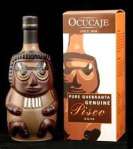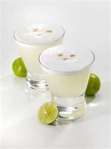article from starchefs.com. An all purpose site for foodies as well as mixologists.
 In the event of a spirits-spat, we all know the guy to call is Cocktail Historian Dave Wondrich. Bearded guardian of spiritsual lore and keeper of cocktail minutiae, Wondrich is the unofficial referee of mixology’s oldest, most esoteric and/or potentially hurtful disputes: the origins of the Brandy Scaffa, the difference between a Tom Collins and a Gin Fiz, and, oh yes, the rightful provenance of pisco. But even if Wondrich knows the how’s, when’s, and what’s of pisco (our attempts at parsing it ended in a boozy stalemate), the spirits librarian seems happier to have the whole catalogue at his fingertips. So when the opportunity came up to create Chilean pisco cocktails for “An Evening with Pisco of Chile” at Eleven Madison Park—part of Chile’s pep-rally push into American markets—Wondrich went for it with the doubly Chilean Santiago Sour.
In the event of a spirits-spat, we all know the guy to call is Cocktail Historian Dave Wondrich. Bearded guardian of spiritsual lore and keeper of cocktail minutiae, Wondrich is the unofficial referee of mixology’s oldest, most esoteric and/or potentially hurtful disputes: the origins of the Brandy Scaffa, the difference between a Tom Collins and a Gin Fiz, and, oh yes, the rightful provenance of pisco. But even if Wondrich knows the how’s, when’s, and what’s of pisco (our attempts at parsing it ended in a boozy stalemate), the spirits librarian seems happier to have the whole catalogue at his fingertips. So when the opportunity came up to create Chilean pisco cocktails for “An Evening with Pisco of Chile” at Eleven Madison Park—part of Chile’s pep-rally push into American markets—Wondrich went for it with the doubly Chilean Santiago Sour.
“I don’t take sides,” Wondrich says of Chilean and Peruvian piscos. “They’re different.” (Fun fact from Dr. Wondrich: before they were countries, Chile and Peru “were part of the same vice royalty in South America,” meaning, in a sense, that pisco kind of came from the same place.) In Peru, pisco is fermented on the skins, making for a (typically) pleasant “funkier” taste. Indeed, the idiosyncrasies of Peruvian pisco are part of its charm: single distillation (it’s bottled at distillation strength), production in smaller batches, addition of the ultra-potent head (or first distillate, impurities and all), protracted contact with grape skin, etc. “When properly managed, that can be delicious,” says Wondrich. “When not properly managed, it can suck.”
different.” (Fun fact from Dr. Wondrich: before they were countries, Chile and Peru “were part of the same vice royalty in South America,” meaning, in a sense, that pisco kind of came from the same place.) In Peru, pisco is fermented on the skins, making for a (typically) pleasant “funkier” taste. Indeed, the idiosyncrasies of Peruvian pisco are part of its charm: single distillation (it’s bottled at distillation strength), production in smaller batches, addition of the ultra-potent head (or first distillate, impurities and all), protracted contact with grape skin, etc. “When properly managed, that can be delicious,” says Wondrich. “When not properly managed, it can suck.”
Chilean pisco avoids the pitfalls (and quirks) of idiosyncrasy with larger format production. “Chilean pisco is a little more consistent,” Wondrich explains. It puts a similar (though more controlled) combination of its Elqui Valley sun-soaked aromatic and non-aromatic grapes through a white wine-style production, finishing with barrel-ageing. So where Peruvian piscos might be said to be terroir-forward, Chilean piscos are more about the process and the ageing. “Some are aged in large rauli wood [local beech], a few months, just to mellow a bit,” says Wondrich. “Others are aged several years in small oak barrels, giving them more dimension.” The general Chilean pisco character, says Wondrich, is “a bit brighter tasting, cleaner,” though he again follows up with a “I try not to take sides on this.”
 For his Santiago Sour, Wondrich kinda had to take sides. “Most people associate the Pisco Sour with egg whites,” he tells us, but the Chilean version “often omits egg whites and bitters for a crisper drink.” Wondrich took his cue from there, going for an ultra-Chilean Pisco Sour that actually doubles up on local product (here’s a hint, the other product is also grape-based). “I like to use local ingredients,” says Wondrich, “something that makes sense in the culture of the producer.” In place of egg white and bitters, Wondrich combines Chilean pisco, orange juice, lemon juice, simple syrup, and a float of Chilean Cabernet Sauvignon. (Another fun fact from Dr. Wondrich: “The sour with a red-wine float predates even the sour with egg white as a category of drink, dating back at least to the 1880s in Chicago.”)
For his Santiago Sour, Wondrich kinda had to take sides. “Most people associate the Pisco Sour with egg whites,” he tells us, but the Chilean version “often omits egg whites and bitters for a crisper drink.” Wondrich took his cue from there, going for an ultra-Chilean Pisco Sour that actually doubles up on local product (here’s a hint, the other product is also grape-based). “I like to use local ingredients,” says Wondrich, “something that makes sense in the culture of the producer.” In place of egg white and bitters, Wondrich combines Chilean pisco, orange juice, lemon juice, simple syrup, and a float of Chilean Cabernet Sauvignon. (Another fun fact from Dr. Wondrich: “The sour with a red-wine float predates even the sour with egg white as a category of drink, dating back at least to the 1880s in Chicago.”)
Why Cabernet? “It has considerably more woody character, almost working like bitters in the drink.” Between the barrel-aging of the pisco and the woodiness of the wine, you might think there might be too much, er, forest in the glass. But Wondrich avoids that by taking it easy on the float, and using Chilean pisco that spends under one year in oak barrels. “I like to use an aromatic pisco,” he says, “Kappa or Waqar. Those are both very floral, made from aromatic grapes. They really do pop.” The result tastes like the love child of the Pisco and New York Sour (a Wondrich favorite). “There’s a little astringency,” Wondrich says. “But underneath it’s a very pleasant drink: floral, light, a little sweet, a little sour, and balanced.”
INGREDIENTS:
METHOD:
Combine the pisco, simple syrup, lemon juice, and orange juice in a shaker with ice. Shake well. Strain into a chilled cocktail glass and carefully float the ½ ounce of Chilean Cabernet on top (it’s easier to float the wine if it’s poured from a Sherry glass or something similar rather than from the bottle; simply pour it gently and slowly over the back of a barspoon held just above the drink).


